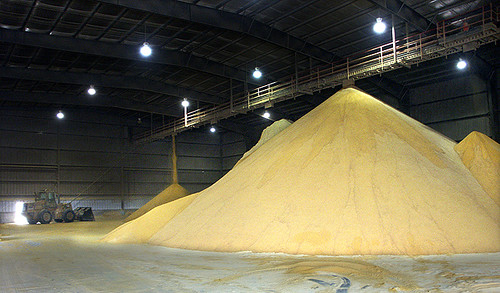
ARS scientists have developed a nearly 100 percent biodegradable kitty litter made from dried distiller's grains, left over from corn-ethanol production.
This post is part of the Science Tuesday feature series on the USDA blog. Check back each week as we showcase stories and news from USDA’s rich science and research portfolio.
Sometimes, the results of USDA science show up in the most unlikely places—maybe even in your cat’s litter box.
USDA Agricultural Research Service (ARS) scientists have discovered a way to make kitty litter that’s nearly 100 percent biodegradable by processing spent grains left over from corn ethanol production.
And what’s good for you and your cat may also be good for the environment. ARS researcher Steven F. Vaughn and his colleagues have shown that litter made with these grains as the starting material may prove to be more environmentally friendly than popular but nonbiodegradable, clay-based litters that mostly end up in landfills.
The idea of using corn or other grains as the basis of an environmentally sound cat litter isn’t new. But the ARS research team at the agency’s National Center for Agricultural Utilization Research in Peoria, Ill., may be the first to extensively study the potential of treated, spent grains called “x-DDGs” as the primary component of a litter, and to make their results publicly available.
DDGs are “dried distiller’s grains.” A DDGs-based litter may provide a new and perhaps higher-value market for the tons of DDGs that corn ethanol refineries now primarily market as an ingredient in cattle feed.
The “x-DDGs” tested by Vaughn’s group are DDGs that, after being used for ethanol production, are treated with one or more solvents to extract any remaining, potentially useful natural compounds.
The team’s laboratory experiments yielded a suggested kitty litter formulation composed of the x-DDGs and three other compounds: glycerol, to prevent the litter from forming dust particles when poured or pawed; guar gum, to help the litter clump easily when wet; and a very small amount of copper sulfate, for odor control.
The resulting litter is highly absorbent, forms strong clumps that don’t crumble when scooped from the litter box, and provides significant odor control, according to Vaughn, who did the work with ARS chemists Mark A. Berhow and Jill K. Winkler-Moser at Peoria, and Edward Lee of Summit Seed, Inc., in Manteno, Ill.
No comments:
Post a Comment
Note: Only a member of this blog may post a comment.